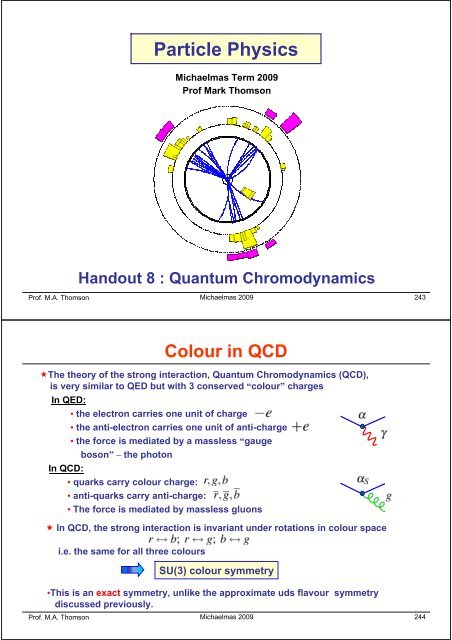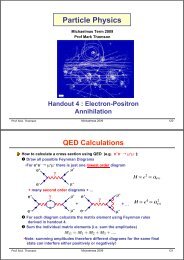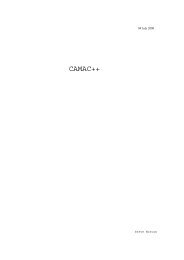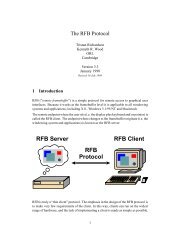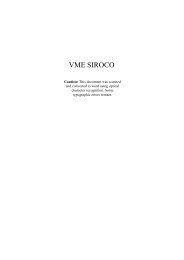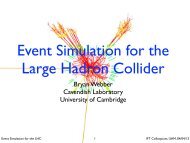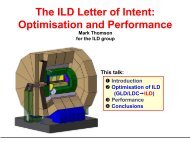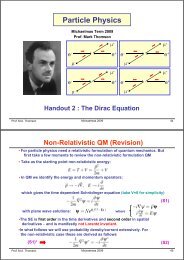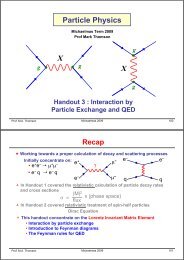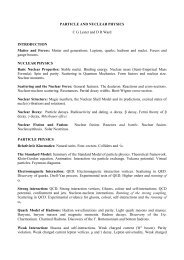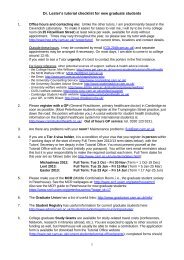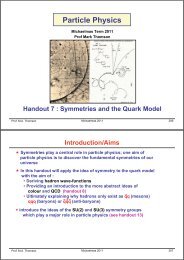Particle Physics - High Energy Physics Group
Particle Physics - High Energy Physics Group
Particle Physics - High Energy Physics Group
Create successful ePaper yourself
Turn your PDF publications into a flip-book with our unique Google optimized e-Paper software.
<strong>Particle</strong> <strong>Physics</strong><br />
Michaelmas Term 2009<br />
Prof Mark Thomson<br />
Handout 8 : Quantum Chromodynamics<br />
Prof. M.A. Thomson Michaelmas 2009 243<br />
Colour in QCD<br />
The theory of the strong interaction, Quantum Chromodynamics (QCD),<br />
is very similar to QED but with 3 conserved “colour” charges<br />
In QED:<br />
• the electron carries one unit of charge<br />
• the anti-electron carries one unit of anti-charge<br />
• the force is mediated by a massless “gauge<br />
boson” –the photon<br />
In QCD:<br />
• quarks carry colour charge:<br />
• anti-quarks carry anti-charge:<br />
• The force is mediated by massless gluons<br />
In QCD, the strong interaction is invariant under rotations in colour space<br />
i.e. the same for all three colours<br />
SU(3) colour symmetry<br />
•This is an exact symmetry, unlike the approximate uds flavour symmetry<br />
discussed previously.<br />
Prof. M.A. Thomson Michaelmas 2009 244
Represent<br />
SU(3) colour states by:<br />
Colour states can be labelled by two quantum numbers:<br />
colour isospin<br />
colour hypercharge<br />
Exactly analogous to labelling u,d,s flavour states by<br />
Each quark (anti-quark) can have the following colour quantum numbers:<br />
and<br />
quarks<br />
anti-quarks<br />
Prof. M.A. Thomson Michaelmas 2009 245<br />
Colour Confinement<br />
It is believed (although not yet proven) that all observed free particles are<br />
“colourless”<br />
•i.e. never observe a free quark (which would carry colour charge)<br />
•consequently quarks are always found in bound states colourless hadrons<br />
Colour Confinement Hypothesis:<br />
only colour singlet states can<br />
exist as free particles<br />
All hadrons must be “colourless” i.e. colour singlets<br />
To construct colour wave-functions for<br />
hadrons can apply results for SU(3) flavour<br />
symmetry to SU(3) colour with replacement<br />
g<br />
r<br />
just as for uds flavour symmetry can<br />
define colour ladder operators<br />
Prof. M.A. Thomson Michaelmas 2009 246<br />
b
Colour Singlets<br />
It is important to understand what is meant by a singlet state<br />
Consider spin states obtained from two spin 1/2 particles.<br />
• Four spin combinations:<br />
• Gives four eigenstates of<br />
spin-1<br />
triplet<br />
spin-0<br />
singlet<br />
The singlet state is “spinless”: it has zero angular momentum, is invariant<br />
under SU(2) spin transformations and spin ladder operators yield zero<br />
In the same way COLOUR SINGLETS are “colourless”<br />
combinations:<br />
they have zero colour quantum numbers<br />
invariant under SU(3) colour transformations<br />
ladder operators all yield zero<br />
NOT sufficient to have : does not mean that state is a singlet<br />
Prof. M.A. Thomson Michaelmas 2009 247<br />
Meson Colour Wave-function<br />
Consider colour wave-functions for<br />
The combination of colour with anti-colour is mathematically identical<br />
to construction of meson wave-functions with uds flavour symmetry<br />
Coloured octet and a colourless singlet<br />
•Colour confinement implies that hadrons only exist in colour singlet<br />
states so the colour wave-function for mesons is:<br />
Can we have a state ? i.e. by adding a quark to the above octet can we form<br />
a state with . The answer is clear no.<br />
bound states do not exist in nature.<br />
Prof. M.A. Thomson Michaelmas 2009 248
Baryon Colour Wave-function<br />
Do qq bound states exist ? This is equivalent to asking whether it possible to<br />
form a colour singlet from two colour triplets ?<br />
• Following the discussion of construction of baryon wave-functions in<br />
SU(3) flavour symmetry obtain<br />
• No qq colour singlet state<br />
• Colour confinement<br />
bound states of qq do not exist<br />
BUT combination of three quarks (three colour triplets) gives a colour<br />
singlet state (pages 235-237)<br />
Prof. M.A. Thomson Michaelmas 2009 249<br />
The singlet colour wave-function is:<br />
Check this is a colour singlet…<br />
• It has : a necessary but not sufficient condition<br />
• Apply ladder operators, e.g. (recall )<br />
•Similarly<br />
Colourless singlet - therefore qqq bound states exist !<br />
Anti-symmetric colour wave-function<br />
Allowed Hadrons i.e. the possible colour singlet states<br />
Mesons and Baryons<br />
Exotic states, e.g. pentaquarks<br />
To date all confirmed hadrons are either mesons or baryons. However, some<br />
recent (but not entirely convincing) “evidence” for pentaquark states<br />
Prof. M.A. Thomson Michaelmas 2009 250
Gluons<br />
In QCD quarks interact by exchanging virtual massless gluons, e.g.<br />
q b<br />
q b<br />
q r<br />
q r<br />
q r q b<br />
q r<br />
rb<br />
br<br />
q b q r<br />
q b q r<br />
q b<br />
Gluons carry colour and anti-colour, e.g.<br />
q b q r q r q r<br />
br rb rr<br />
Gluon colour wave-functions<br />
(colour + anti-colour) are the same<br />
as those obtained for mesons<br />
(also colour + anti-colour)<br />
OCTET +<br />
“COLOURLESS” SINGLET<br />
Prof. M.A. Thomson Michaelmas 2009 251<br />
So we might expect 9 physical gluons:<br />
OCTET:<br />
SINGLET:<br />
BUT, colour confinement hypothesis:<br />
only colour singlet states<br />
can exist as free particles<br />
Colour singlet gluon would be unconfined.<br />
It would behave like a strongly interacting<br />
photon infinite range Strong force.<br />
Empirically, the strong force is short range and therefore know that the physical<br />
gluons are confined. The colour singlet state does not exist in nature !<br />
NOTE: this is not entirely ad hoc. In the context of gauge field theory (see minor<br />
option) the strong interaction arises from a fundamental SU(3) symmetry.<br />
The gluons arise from the generators of the symmetry group (the<br />
Gell-Mann matrices). There are 8 such matrices 8 gluons.<br />
Had nature “chosen” a U(3) symmetry, would have 9 gluons, the additional<br />
gluon would be the colour singlet state and QCD would be an unconfined<br />
long-range force.<br />
NOTE: the “gauge symmetry” determines the exact nature of the interaction<br />
FEYNMAN RULES<br />
Prof. M.A. Thomson Michaelmas 2009 252
Gluon-Gluon Interactions<br />
In QED the photon does not carry the charge of the EM interaction (photons are<br />
electrically neutral)<br />
In contrast, in QCD the gluons do carry colour charge<br />
Gluon Self-Interactions<br />
Two new vertices (no QED analogues)<br />
triple-gluon<br />
vertex<br />
quartic-gluon<br />
vertex<br />
In addition to quark-quark scattering, therefore can have gluon-gluon scattering<br />
e.g. possible<br />
way of arranging<br />
the colour flow<br />
Prof. M.A. Thomson Michaelmas 2009 253<br />
Gluon self-Interactions and Confinement<br />
Gluon self-interactions are believed to give<br />
rise to colour confinement<br />
Qualitative picture:<br />
•Compare QED with QCD<br />
•In QCD “gluon self-interactions squeeze<br />
lines of force into a flux tube”<br />
What happens when try to separate two coloured objects e.g. qq<br />
q<br />
q<br />
e +<br />
e -<br />
q<br />
q<br />
•Form a flux tube of interacting gluons of approximately constant<br />
energy density<br />
•Require infinite energy to separate coloured objects to infinity<br />
•Coloured quarks and gluons are always confined within colourless states<br />
•In this way QCD provides a plausible explanation of confinement – but<br />
not yet proven (although there has been recent progress with Lattice QCD)<br />
Prof. M.A. Thomson Michaelmas 2009 254
Hadronisation and Jets<br />
Consider a quark and anti-quark produced in electron positron annihilation<br />
q q<br />
i) Initially Quarks separate at<br />
high velocity<br />
ii) Colour flux tube forms<br />
between quarks<br />
iii) <strong>Energy</strong> stored in the<br />
flux tube sufficient to<br />
produce qq pairs<br />
iv) Process continues<br />
until quarks pair<br />
up into jets of<br />
colourless hadrons<br />
This process is called hadronisation. It is not (yet) calculable.<br />
The main consequence is that at collider experiments quarks and gluons<br />
observed as jets of particles<br />
e +<br />
q<br />
<br />
q<br />
q<br />
q<br />
q<br />
q<br />
q<br />
e –<br />
q<br />
Prof. M.A. Thomson Michaelmas 2009 255<br />
QCD and Colour in e + e - Collisions<br />
e + e – colliders are an excellent place to study QCD<br />
e +<br />
e –<br />
<br />
q<br />
q<br />
Well defined production of quarks<br />
• QED process well-understood<br />
• no need to know parton structure functions<br />
• + experimentally very clean – no proton remnants<br />
In handout 5 obtained expressions for the<br />
cross-section<br />
• In e + e – collisions produce all quark flavours<br />
for which<br />
• In general, i.e. unless producing a bound state,<br />
produce jets of hadrons<br />
• Usually can’t tell which jet<br />
came from the quark and<br />
came from anti-quark<br />
Angular distribution of jets<br />
Quarks are spin ½<br />
H.J.Behrend et al., Phys Lett 183B (1987) 400<br />
Prof. M.A. Thomson Michaelmas 2009 256
Colour is conserved and quarks are produced as<br />
For a single quark flavour and single colour<br />
• Experimentally observe jets of hadrons:<br />
Factor 3 comes from colours<br />
• Usual to express as ratio compared to<br />
u,d,s:<br />
u,d,s,c:<br />
u,d,s,c,b:<br />
Data consistent with expectation<br />
with factor 3 from colour<br />
Prof. M.A. Thomson Michaelmas 2009 257<br />
Jet production in e+e- Collisions<br />
e + e – colliders are also a good place to study gluons<br />
OPAL at LEP (1989-2000)<br />
e +<br />
Z<br />
q<br />
e +<br />
<br />
q<br />
e +<br />
<br />
q<br />
e –<br />
q e –<br />
q e –<br />
Experimentally:<br />
•Three jet rate measurement of<br />
•Angular distributions gluons are spin-1<br />
•Four-jet rate and distributions QCD has an underlying SU(3) symmetry<br />
Prof. M.A. Thomson Michaelmas 2009 258<br />
q
The Quark – Gluon Interaction<br />
•Representing the colour part of the fermion wave-functions by:<br />
•<strong>Particle</strong> wave-functions<br />
•The QCD qqg vertex is written:<br />
q<br />
q<br />
•Only difference w.r.t. QED is the insertion of the 3x3<br />
SU(3) Gell-Mann matrices (justified in handout 13).<br />
•Isolating the colour part:<br />
Gluon a<br />
colour i j<br />
•Hence the fundamental quark - gluon QCD interaction can be written<br />
Prof. M.A. Thomson Michaelmas 2009 259<br />
External Lines<br />
spin 1/2<br />
spin 1<br />
Feynman Rules for QCD<br />
incoming quark<br />
outgoing quark<br />
incoming anti-quark<br />
outgoing anti-quark<br />
incoming gluon<br />
outgoing gluon<br />
Internal Lines (propagators)<br />
spin 1 gluon<br />
Vertex Factors<br />
spin 1/2 quark<br />
a, b = 1,2,…,8 are gluon colour indices<br />
i, j = 1,2,3 are quark colours,<br />
a = 1,2,..8 are the Gell-Mann SU(3) matrices<br />
+ 3 gluon and 4 gluon interaction vertices<br />
Matrix Element -iM = product of all factors<br />
Prof. M.A. Thomson Michaelmas 2009 260
Matrix Element for quark-quark scattering<br />
Consider QCD scattering of an up and a down quark<br />
u<br />
d<br />
u<br />
d<br />
•The incoming and out-going quark colours are<br />
labelled by<br />
• In terms of colour this scattering is<br />
• The 8 different gluons are accounted for by<br />
the colour indices<br />
•NOTE: the -function in the propagator ensures<br />
a = b, i.e. the gluon “emitted” at a is the<br />
same as that “absorbed” at b<br />
Applying the Feynman rules:<br />
where summation over a and b (and and ) is implied.<br />
Summing over a and b using the -function gives:<br />
Sum over all 8 gluons (repeated indices)<br />
Prof. M.A. Thomson Michaelmas 2009 261<br />
QCD vs QED<br />
QED<br />
e –<br />
e –<br />
– –<br />
QCD<br />
u<br />
u<br />
QCD Matrix Element = QED Matrix Element with:<br />
•<br />
or equivalently<br />
d<br />
d<br />
+ QCD Matrix Element includes an additional “colour factor”<br />
Prof. M.A. Thomson Michaelmas 2009 262
Evaluation of QCD Colour Factors<br />
•QCD colour factors reflect the gluon states that are involved<br />
Gluons:<br />
Configurations involving a single colour<br />
r<br />
r<br />
•Only matrices with non-zero entries in 11 position are involved<br />
r<br />
r<br />
Similarly find<br />
Prof. M.A. Thomson Michaelmas 2009 263<br />
Other configurations where quarks don’t change colour<br />
r<br />
r<br />
e.g.<br />
•Only matrices with non-zero entries in 11 and 33 position<br />
are involved<br />
b<br />
b<br />
Similarly<br />
Configurations where quarks swap colours<br />
r<br />
g<br />
e.g.<br />
•Only matrices with non-zero entries in 12 and 21 position<br />
are involved<br />
g<br />
r<br />
Gluons<br />
Configurations involving 3 colours<br />
r<br />
b<br />
b<br />
g<br />
Prof. M.A. Thomson Michaelmas 2009 264<br />
e.g.<br />
•Only matrices with non-zero entries in the 13 and 32 position<br />
•But none of the matrices have non-zero entries in the<br />
13 and 32 positions. Hence the colour factor is zero<br />
colour is conserved
Colour Factors : Quarks vs Anti-Quarks<br />
• Recall the colour part of wave-function:<br />
• The QCD qqg vertex was written:<br />
Now consider the anti-quark vertex<br />
• The QCD qqg vertex is:<br />
q<br />
q<br />
Note that the incoming anti-particle now enters on the LHS of the expression<br />
•For which the colour part is<br />
i.e indices ij are<br />
swapped with respect<br />
to the quark case<br />
• Hence<br />
• c.f. the quark - gluon QCD interaction<br />
Prof. M.A. Thomson Michaelmas 2009 265<br />
Finally we can consider the quark – anti-quark annihilation<br />
q<br />
QCD vertex:<br />
with<br />
q<br />
Prof. M.A. Thomson Michaelmas 2009 266
• Consequently the colour factors for the different diagrams are:<br />
q<br />
q<br />
e.g.<br />
q<br />
q<br />
q<br />
q<br />
q<br />
q<br />
q<br />
q<br />
q<br />
q<br />
Colour index of adjoint spinor comes first<br />
Prof. M.A. Thomson Michaelmas 2009 267<br />
Quark-Quark Scattering<br />
•Consider the process which can occur in the<br />
high energy proton-proton scattering<br />
jet<br />
• There are nine possible colour configurations<br />
of the colliding quarks which are all equally<br />
p<br />
likely.<br />
• Need to determine the average matrix element which<br />
is the sum over all possible colours divided by the<br />
number of possible initial colour states<br />
jet<br />
d<br />
u<br />
d<br />
u<br />
p<br />
• The colour average matrix element contains the average colour factor<br />
•For<br />
rrrr,.. rbrb,.. rbbr,..<br />
Prof. M.A. Thomson Michaelmas 2009 268
•Previously derived the Lorentz Invariant cross section for e – – e – –<br />
elastic scattering in the ultra-relativistic limit (handout 6).<br />
QED<br />
•For ud ud in QCD replace<br />
and multiply by<br />
QCD<br />
•Here is the centre-of-mass energy of the quark-quark collision<br />
•The calculation of hadron-hadron scattering is very involved, need to<br />
include parton structure functions and include all possible interactions<br />
e.g. two jet production in proton-antiproton collisions<br />
Prof. M.A. Thomson Michaelmas 2009 269<br />
e.g. pp collisions at the Tevatron<br />
Tevatron collider at Fermi National Laboratory (FNAL)<br />
• located ~40 miles from Chigaco, US<br />
• started operation in 1987 (will run until 2009/2010)<br />
pp collisions at s = 1.8 TeV<br />
c.f. 14 TeV at the LHC<br />
Tevatron<br />
900 GeV p<br />
Main Injector<br />
120 GeV p<br />
Two main accelerators:<br />
Main Injector<br />
• Accelerates 8 GeV<br />
to 120 GeV<br />
• also to 120 GeV<br />
• Protons sent to<br />
Tevatron & MINOS<br />
• all go to Tevatron<br />
Tevatron<br />
• 4 mile circumference<br />
• accelerates from<br />
120 GeV to 900 GeV<br />
Prof. M.A. Thomson Michaelmas 2009 270
Test QCD predictions by looking at production of pairs of high energy jets<br />
pp jet jet + X<br />
Prof. M.A. Thomson Michaelmas 2009 271<br />
p<br />
p<br />
Measure cross-section in terms of<br />
• “transverse energy”<br />
• “pseudorapidity”<br />
…don’t worry too much about the details here,<br />
what matters is that…<br />
= 5.7-15 o<br />
= 62-90 o<br />
D0 Collaboration, Phys. Rev. Lett. 86 (2001)<br />
QCD predictions provide an<br />
excellent description of the data<br />
NOTE:<br />
• at low E T cross-section is<br />
dominated by low x partons<br />
i.e. gluon-gluon scattering<br />
• at high E T cross-section is<br />
dominated by high x partons<br />
i.e. quark-antiquark scattering<br />
Prof. M.A. Thomson Michaelmas 2009 272
QED<br />
Running Coupling Constants<br />
• “bare” charge of electron screened<br />
by virtual e + e – pairs<br />
• behaves like a polarizable dielectric<br />
In terms of Feynman diagrams:<br />
-Q<br />
<br />
<br />
<br />
<br />
<br />
<br />
+Q<br />
<br />
<br />
<br />
<br />
<br />
<br />
<br />
+ + +……<br />
Some final state so add matrix element amplitudes:<br />
Giving an infinite series which can be summed and is equivalent to<br />
a single diagram with “running” coupling constant<br />
Note sign<br />
Prof. M.A. Thomson Michaelmas 2009 273<br />
Might worry that coupling becomes<br />
infinite at<br />
OPAL Collaboration, Eur. Phys. J. C33 (2004)<br />
i.e. at<br />
• But quantum gravity effects would come<br />
in way below this energy and it is<br />
highly unlikely that QED “as is” would<br />
be valid in this regime<br />
In QED, running coupling increases<br />
very slowly<br />
•Atomic physics:<br />
•<strong>High</strong> energy physics:<br />
Prof. M.A. Thomson Michaelmas 2009 274
QCD<br />
Running of s<br />
Similar to QED but also have gluon loops<br />
+ + + +…<br />
Fermion Loop<br />
Boson Loops<br />
Remembering adding amplitudes, so can get negative interference and the sum<br />
can be smaller than the original diagram alone<br />
Bosonic loops “interfere negatively”<br />
with<br />
= no. of colours<br />
= no. of quark flavours<br />
S decreases with Q 2 Nobel Prize for <strong>Physics</strong>, 2004<br />
(Gross, Politzer, Wilczek)<br />
Prof. M.A. Thomson Michaelmas 2009 275<br />
Measure S in many ways:<br />
• jet rates<br />
• DIS<br />
• tau decays<br />
• bottomonium decays<br />
• +…<br />
0.4<br />
0.3<br />
α s (µ)<br />
0.2<br />
QCD<br />
Prediction<br />
As predicted by QCD,<br />
S decreases with Q 2<br />
0.1<br />
0.0<br />
1 2 5 10 20 50 100 200<br />
µ (GeV)<br />
At low : S is large, e.g. at find S ~ 1<br />
•Can’t use perturbation theory ! This is the reason why QCD calculations at<br />
low energies are so difficult, e.g. properties hadrons, hadronisation of<br />
quarks to jets,…<br />
At high : S is rather small, e.g. at find S ~ 0.12<br />
Asymptotic Freedom<br />
•Can use perturbation theory and this is the reason that in DIS at high<br />
quarks behave as if they are quasi-free (i.e. only weakly bound within hadrons)<br />
Prof. M.A. Thomson Michaelmas 2009 276
Summary<br />
Superficially QCD very similar to QED<br />
But gluon self-interactions are believed to result in colour confinement<br />
All hadrons are colour singlets which explains why only observe<br />
Mesons<br />
Baryons<br />
A low energies<br />
Can’t use perturbation theory !<br />
Non-Perturbative regime<br />
Coupling constant runs, smaller coupling at higher energy scales<br />
Can use perturbation theory<br />
Asymptotic Freedom<br />
Where calculations can be performed, QCD provides a good description<br />
of relevant experimental data<br />
Prof. M.A. Thomson Michaelmas 2009 277<br />
Appendix I: Alternative evaluation of colour factors<br />
The colour factors can be obtained (more intuitively) as follows :<br />
u<br />
u<br />
•Write<br />
•Where the colour coefficients at the two<br />
vertices depend on the quark and gluon<br />
colours<br />
“Non-examinable”<br />
but can be used<br />
as to derive colour<br />
factors.<br />
d<br />
d<br />
r<br />
b<br />
r<br />
r<br />
•Sum over all possible exchanged gluons conserving<br />
colour at both vertices<br />
Prof. M.A. Thomson Michaelmas 2009 278
Configurations involving a single colour<br />
e.g. : two possible exchanged gluons<br />
r<br />
r<br />
r<br />
r<br />
r<br />
r<br />
r<br />
r<br />
e.g. : only one possible exchanged gluon<br />
b<br />
b<br />
b<br />
b<br />
Prof. M.A. Thomson Michaelmas 2009 279<br />
Other configurations where quarks don’t change colour<br />
r<br />
r<br />
b<br />
b<br />
Configurations where quarks swap colours<br />
r<br />
g<br />
g<br />
r<br />
Prof. M.A. Thomson Michaelmas 2009 280
Appendix II: Colour Potentials<br />
•Previously argued that gluon self-interactions lead to a long-range<br />
potential and that this is likely to explain colour confinement<br />
•Have yet to consider the short range potential – i.e. for quarks in mesons<br />
and baryons does QCD lead to an attractive potential?<br />
•Analogy with QED: (NOTE this is very far from a formal proof)<br />
Non-examinable<br />
QED<br />
e – e –<br />
e – e –<br />
e –<br />
e –<br />
Repulsive Potential<br />
Static<br />
e +<br />
e +<br />
Attractive Potential<br />
QCD<br />
q<br />
by analogy with QED expect potentials of form<br />
q<br />
q<br />
q<br />
q<br />
q<br />
q<br />
q<br />
Whether it is a attractive or repulsive potential depends on sign of colour factor<br />
Prof. M.A. Thomson Michaelmas 2009 281<br />
Consider the colour factor for a qq system in the colour singlet state:<br />
with colour potential<br />
•Following the QED analogy:<br />
r<br />
r<br />
which is the term arising from<br />
•Have 3 terms like and 6 like<br />
r<br />
r<br />
NEGATIVE<br />
ATTRACTIVE<br />
•The same calculation for a qq colour octet state, e.g. gives a positive<br />
repulsive potential:<br />
Whilst not a formal proof, it is comforting to see that in the colour singlet<br />
state the QCD potential is indeed attractive.<br />
(question 15)<br />
Prof. M.A. Thomson Michaelmas 2009 282
Combining the short-range QCD<br />
potential with the linear long-range<br />
term discussed previously:<br />
This potential is found to give a good<br />
description of the observed charmonium (cc)<br />
and bottomonium (bb) bound states.<br />
V(r)<br />
1 fm<br />
r<br />
cc bb NOTE:<br />
•c, b are heavy quarks<br />
•approx. non-relativistic<br />
•orbit close together<br />
•probe 1/r part of V QCD<br />
Agreement of data with<br />
prediction provides strong<br />
evidence that has the<br />
Expected form<br />
Prof. M.A. Thomson Michaelmas 2009 283


